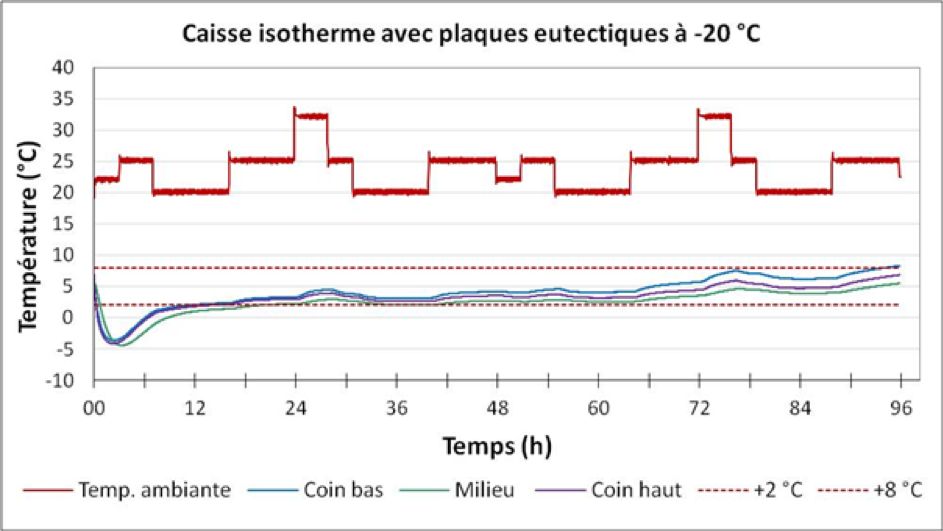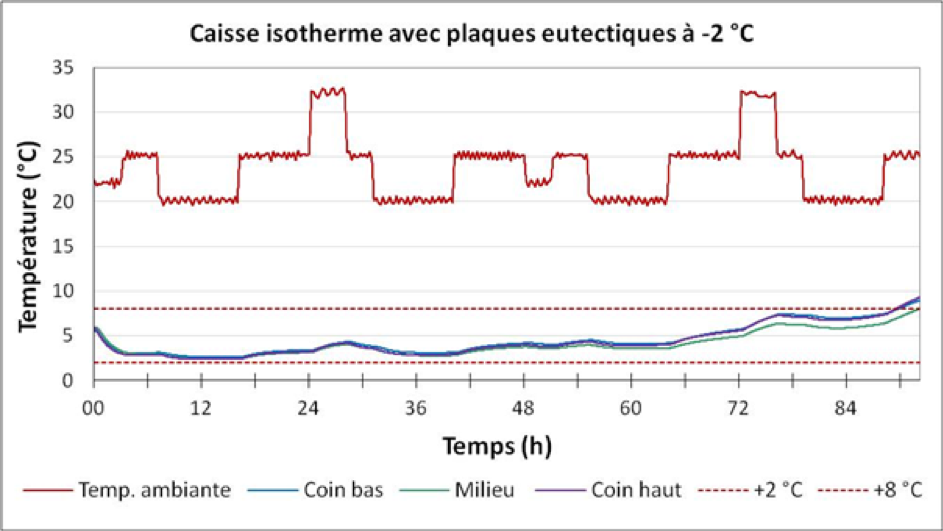Thematic studies
News
Case studies
Stabilisation protocols for eutectic plates
Preparation of eutectic plates used in insulated packaging is an important step to secure the cold chain of healthcare products. Depending on the nature of the products and the temperature profile, these thermal storage units must be inserted into the packaging solutions at a predetermined temperature. In this article we analyse the two procedures for preparing eutectic plates.

Properties and method for preparing eutectic plates
Properties of aqueous eutectic solutions
The eutectic solution compensates for the heat exchanged between the interior and exterior of the insulated container and replaces the need to use an external energy source.
With a high latent heat (334 kJ/kg), and non-toxic, non-flammable and economical, the aqueous eutectic solutions are most commonly used in insulated packaging. Compared with other phase-change materials, 0 °C water-based solutions are most commonly used for the range +2/+8 °C under hot temperature profiles (> +15 °C).
The efficiency of eutectic solutions is improved by presenting them in the form of gels with the addition of viscosity control agents. The viscosity suppresses or reduces convection and slows down melting, which results in a greater restitution time than that of water.
The number of thermal storage units to be placed in an insulated packaging solution depends on several factors. The main parameters are:
- thermal storage capacity of the eutectic solution used;
- overall heat transfer K coefficient of the insulated container;
- external temperature profile and the logistical circuit;
- requirements of the product to be shipped.
Preparation procedures for eutectic plates
Let us take the example of 0°C eutectic plates. They are used as thermal storage units in insulated containers to maintain heat-sensitive healthcare products between +2 °C and +8 °C.
Before placing them into the packaging unit, these eutectic plates are generally frozen using standard equipment at approximately -20 °C, and then stabilised or raised to a temperature close to their melting point (approximately -2 °C). Performed according to a validated protocol, this procedure uses the latent phase of the eutectic solution and prevents the products being shipped from dropping below the lower limit of +2 °C.
The procedure used to reach this temperature depends on the available resources and the number of thermal storage units to be prepared. They can be stabilised at -2 °C by storing in a second chamber or, in the absence of such equipment, left at room temperature for a period of time to raise their temperature.
Impact of introduction temperature of the eutectic plates in the insulated packaging
Thermal efficiency testing of eutectic plates with and without stabilisation
In order to study the impact of the introduction temperature of the eutectic plates, thermal efficiency tests were performed on the same insulated container with plates inserted at -20 °C and -2 °C. These tests were performed in accordance with a protocol specifying the metrology conditions and requirements.
Test protocol:
Container tested: An insulated container made from polyurethane panels with a thickness of 60 mm, an internal volume of 29 litres and equipped with 8 eutectic plates at 0 °C.
Test load: Standard product (such as vaccines), according to the NF S 99-700 standard
Thermal pre-packaging :
- The eutectic plates are frozen at -20 °C for at least 48 hours.
- The products are stabilised in a cold chamber at +5 °C for at least 24 hours.
- The insulated container is stabilised at +22 °C for at least 24 hours.
Test equipment: For these thermal efficiency tests, Pt100 temperature sensors are used to measure the temperature inside the container and the external temperature. The tests are performed in a programmable thermostatic chamber.
Temperature profile: The temperature profile used for the tests is the standard profile ST-96-b defined by the NF S 99-700 standard.
Positioning of temperature sensors: Three internal sensors are fixed to the products and placed in the bottom corner, the middle and the top corner. A fourth sensor is placed in the thermostatic chamber to record the ambient temperature throughout the duration of the test.
Setting up the configuration and initiating the tests: Loading of the container is carried out at a room temperature of +22 °C. The loaded container is placed in the test chamber, then the programmed temperature profile is initiated.
Results:
Eutectic plates inserted at – 20 °C: In this test, 8 frozen eutectic plates stabilised at - 20 °C for at least 48 hours were inserted directly into the container. The internal and external temperatures recorded are shown in figure 1. There was a drop in temperature during the first few hours of testing. The three sensors recorded negative temperatures for 6 to 7 hours, which can cause the product to freeze. The minimum temperature of -4.4 °C was recorded after 3 hours of testing. The container kept the products below +8 °C for 94 hours.

Figure 1. : Efficiency of the container with eutectic plates inserted at -20 °C.
Eutectic plates inserted at – 2 °C: In this test, the eutectic plates were frozen at -20 °C for at least 48 hours, then stabilised in another freezer at -2 °C for at least 24 hours before being placed in the container. The temperatures recorded are shown in figure 2. The three sensors recorded temperatures above +2 °C throughout the entire duration of the test, thereby preventing any risk of the products freezing. The container kept the products between +2 °C and +8 °C for 88 hours.

Figure 2.: Efficiency of the container with eutectic plates inserted at -2 °C.
Preparation protocol for individual eutectic plates
Increase to -2 °C from exposure to room temperature
Many users of eutectic plates do not have two separate pieces of equipment, one for freezing below -15 °C and another for stabilisation at -2 °C. In which case, a procedure based on an empirical method is recommended. This preparation procedure consists of freezing the eutectic plates (generally at -20 °C approx.) and then leaving them at room temperature until they reach about -2 °C. The choice of the target -2 °C makes it possible to use the latent phase of the eutectic solution at 0 °C and prevent the risk of freezing the products to be shipped. The temperature increase time is determined by the type of eutectic plate, as shown in the tables below:
Durations of temperature increases from -20 °C to -2 °C:
|
|
Duration of temperature increase from -20 °C to -2 °C | |
|
External temperature |
Plate thickness 15 mm |
Plate thickness 30 mm |
|
+15 °C |
30 minutes |
60 minutes |
|
+20 °C |
25 minutes |
50 minutes |
|
+25 °C |
20 minutes |
40 minutes |
Durations of temperature increases of the same eutectic plates below an external temperature of +20 °C:
|
|
Duration of increase up to -2 °C below +20 °C | |
| Freezing temperature | Plate thickness 15 mm | Plate thickness 30 mm |
|
-15 °C |
20 minutes |
40 minutes |
|
-20 °C |
25 minutes |
50 minutes |
|
-25 °C |
30 minutes |
60 minutes |
Test protocol:
The tests are performed on two types of plates with a 0 °C aqueous eutectic solution that are the same length and width but with average net thicknesses of 30 mm and 15 mm respectively. The eutectic solution masses are 700 g and 350 g.
A sensor is placed in the centre of the eutectic plate in the midst of the solution. In order to verify the repeatability of results, the test is performed simultaneously on three identical plates and repeated three times. The temperature sensors are calibrated within the working range.
The eutectic plates equipped with instruments are completely frozen and stabilised in the same freezer at -20 °C. They are then placed at room temperature in a test chamber while avoiding exposing them to the flow of mechanical ventilation. For each type of eutectic plate, the tests are performed below +15 °C, below +20 °C and below +25 °C.
The temperature increase of the solution is recorded for each plate according to the time. The mean temperature values are shown in figures 3, 4 and 5 below +15 °C, +20 °C and +25 °C respectively.
Figure 3.: Temperature increase of individual eutectic plates below +15 °C.
Figure 4.: Temperature increase of individual eutectic plates below +20 °C.
Figure 5.: Temperature increase of individual eutectic plates below +25 °C.
Preparation protocol for eutectic plates by pallet
Many users (pharmaceutical laboratories, dispatchers, distributors…) use large numbers of thermal storage units to ship temperature-controlled products. In this case, the management and preparation of the thermal storage units cannot be done with individual plates.
Tests were performed on a complete pallet with storage units to determine a procedure for preparing a large number of eutectic plates or trays.
Temperature increase of a pallet with eutectic plates
The aim of this test is to study the temperature increase up to -2 °C with a complete pallet with boxes of eutectic plates, while exposing it to room temperature.
Temperature sensors are placed in the eutectic plates in the peripheral boxes and in the centre of the pallet (favourable and unfavourable positions). The complete pallet is frozen and stabilised at -20 °C then left at a room temperature of +20 °C. The temperature increase time is shown in figure 6.
Figure 6.: Temperature increase of a pallet with eutectic plates below +20 °C.
This test shows the difficultly, if not the impossibility, of managing the temperature increase of a complete pallet with thermal storage units while exposing it to room temperature. Significant differences were recorded between the peripheral eutectic plates and those placed in the middle. The mean duration of temperature increase from -20 °C to -2 °C varies from 2 hours for the peripheral boxes to 26 hours for the boxes placed in the centre of the pallet.
Stabilisation of a pallet with eutectic trays in a chamber at -2 °C
In some cases, several eutectic plates can be grouped together in a tray. The test was performed on a complete pallet with eutectic trays separated by supports allowing air circulation, as delivered by the supplier. The aim of this test is to study the preparation of a complete pallet with eutectic trays, in two parts:
- The first consists of freezing the pallet in a chamber at a temperature below -20 °C.
- The second consists of stabilising this pallet in another chamber at -2 °C.
Temperature sensors are placed in the peripheral eutectic plates and at the centre of the pallet to monitor freezing and thermal stabilisation of the favourable and unfavourable points of the pallet. The temperature profile for these representative points is shown in figure 7.
Figure 7.: Freezing and stabilisation at -2 °C of a pallet with eutectic trays.
We can see the trays cooling from +20 °C to 0 °C then freezing at 0 °C for a period of less than 24 hours. After 36 hours all eutectic trays are stabilised at the temperature of the freezing chamber (below -20 °C). The pallet is then placed in a second chamber at -2 °C in which the trays are fully stabilised after 24 hours. A total duration of 72 hours is enough to freeze then stabilise a pallet complete with eutectic trays with gaps at -2 °C. Without air circulation between the trays, the preparation time will be longer.
The correct procedure for preparing a pallet of thermal storage units is to use two chambers, the first at approximately -20 °C to completely freeze the plates (or trays) and the second at -2 °C for thermal stabilisation and storage.
Conclusion
Preparation of the thermal storage units is an important step in the correct use of insulated containers and the security of the healthcare products cold chain. Thermal stabilisation and insertion of eutectic plates at -2 °C prevents the products from freezing. The correct procedure depends on the number of storage units to be prepared and the methods used.
After freezing, the individual plates can be stabilised in a chamber at -2 °C or left at room temperature (between +15 °C and +20 °C) for a specified period depending on the size of the plate, the freezing temperature and the room temperature.
After freezing, the pallets complete with eutectic plates or trays require thermal stabilisation in a chamber at -2 °C.
Authors : Abbes Kacimi, Cold Chain Expertise Director, Sofrigam / David Stienne, Ater Métrologie Laboratory Manager